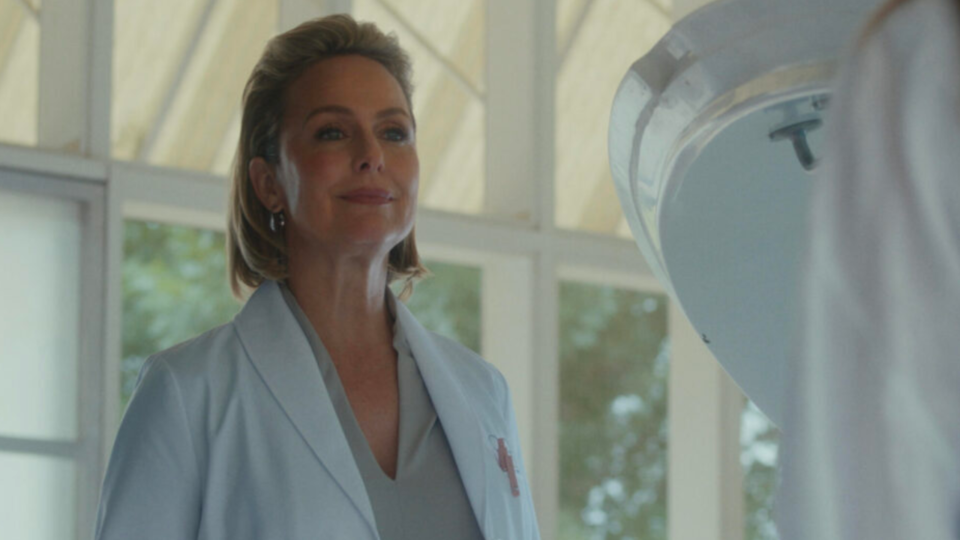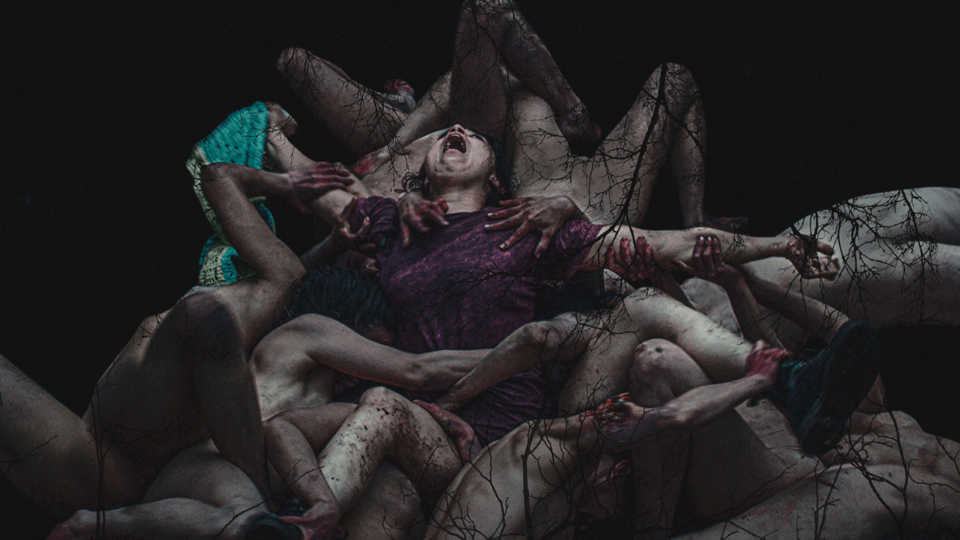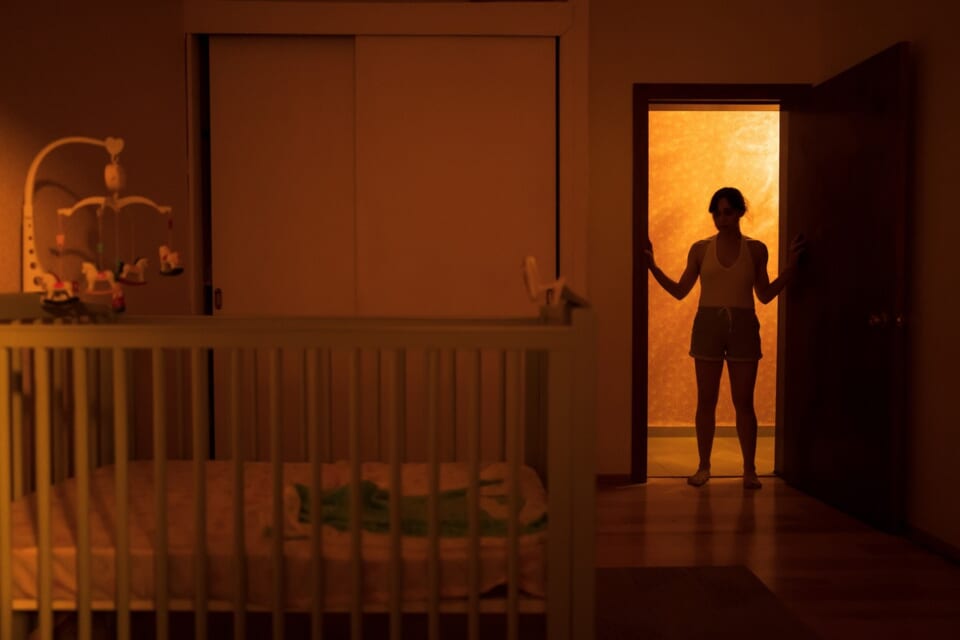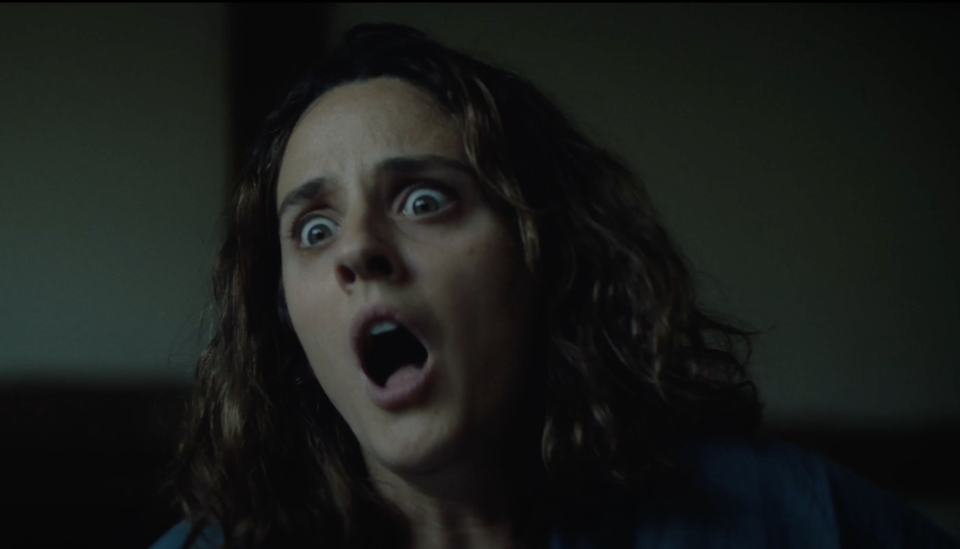Pregnancy Horror in a Post-Roe World

Pregnancy has long been used to explore power, control, identity, and the body in horror. From the classic Rosemary’s Baby to more modern films like False Positive, the pregnant body has been an ongoing motif. With the battle over the right to choose in recent years and the overturning of Roe v. Wade in June 2022, pregnancy horror films like Clock (an exploration of societal pressure to have children), Huesera: The Bone Woman (an examination of the idea of pregnancy versus the reality of it), and Baby Ruby (a harrowing depiction of postpartum depression) feel even more urgent than they have in years past.
Clock (released on Hulu in 2023) was written and directed by Alexis Jacknow. Dianna Agron stars as Ella, a woman who is content in her life with her husband, her fabulous career as a designer (known for her special eye for color), and her freedom as a child-free woman. Even so, gradually the pressure from her friends and her father—who reminds Ella frequently that she is the great-grandchild of Holocaust survivors and should procreate—cause her to question her own judgment. She begins to worry that her biological clock hasn’t kicked in, and her gynecologist encourages her to enroll in a special program guaranteed to jumpstart her biological clock.
Also Read: Reviving Frankenstein’s Monster in the Midst of Mass Death
At first glance, it can be hard to believe that Ella would opt to drastically alter her life plan after urging from friends, family, and a doctor who suggests her clock is “broken.” But women are subject to this treatment every day. Societal pressure to have a child adds up. While Ella is secretly thankful for her own lifestyle when her friends gab about the more gruesome parts of childbirth (and child-rearing), she also feels like an “other.” She’s on a different side of the fence than her friends who have become parents. It’s no wonder that she tries to get in touch with a part of her that wants children.
The doctor running the experimental program (a deliciously diabolical Melora Hardin, sporting extreme villain hair) keeps giving Ella and the other women at the treatment facility mysterious pills, even as the side effects they’re experiencing continue to worsen. Ella hallucinates terrifying images— including the gaunt ghost of her great-grandmother emerging from the concentration camp—and has visions of herself with a baby dangling from its umbilical cord between her legs, like a swinging pendulum in a clock.

Worst of all, her sense of color is dulled; she is rendered almost colorblind by enduring her doctor’s treatment. By trying to force her body into doing something she doesn’t want to do, she begins to lose essential parts of how she is and how she sees the world.
Also Read: The Formative Body Horror of Spongebob Squarepants
Clock also touches on body horror, particularly when it comes to the treatment of uterus-having bodies by the medical system. Her doctor places an implant inside of her to increase her chances of getting pregnant (and wanting to be pregnant), and she refuses to remove it when Ella realizes the treatments are doing more harm than good. Undeterred, Ella must use pliers to reach inside and remove the implant herself, accompanied by squelching wet noises that would make even the most seasoned horror fan queasy.
As more and more states have restricted the rights to choose and to have access to safe abortions in the last few years, more people have had to turn to more dangerous ways to end their pregnancies. It’s difficult not to connect Ella’s struggle to remove her unwanted implant with the struggles of people across the U.S. (and the world) who must turn to medically unsound and potentially life-threatening ways of obtaining abortions. Unfortunately, this return to a pre-Roe v. Wade era puts innumerable people in precarious positions; many must risk their lives to receive reproductive health care.
Ella’s gynecological exams are also more accurate than how these exams were depicted in the past. In the ’90s or ’00s, cis women were often shown placidly laying back on the exam table, their feet comfy in stirrups, as their doctors did what seemed like an easy and pain-free exam. Ella is shown gripping the armrest tighter and tighter during the presumably painful exams she endures. During some of her pelvic exams, she’s in a dark, sterile room, and she appears to be suffering. This may be a horror movie, but real-life exams can be just as painful and as violating as what Ella goes through during Clock.
Also Read: The Liminal, Queer Horror of Kitty Horrorshow
Pregnancy horror movies like Clock have ratcheted up the tension during these medical scenes, especially in recent years as reproductive health has become a fraught battleground. In 2021’s False Positive, Ilana Glazer (an outspoken advocate for the right to choose, who has also called attention to the devastating prevalence of pelvic pain) stars as Lucy, a woman who is inseminated by her doctor. During her pelvic exams, the camera stays on Glazer’s face as she fights to remain calm while experiencing bodily agony. Unlike the wetter sounds of Ella’s exams in Clock, the exams in False Positive are accompanied by an even more disturbing soundtrack: the click click click of a speculum.

The 2023 Mexican horror film Huesera: The Bone Woman, which was directed by Michelle Garza Cervera, and written by Cervera and Abia Castillo, does not take place in the U.S., yet still reflects the anxiety of the post-Roe v. Wade era. The luminous Natalia Solián stars as Valeria. Like Ella, she’s a woman happy with her husband and her impressive career as a furniture maker. When she gets pregnant, her initial happiness turns into an all-consuming anxiety and fear about her abilities as a mother.
Her family members routinely mock her about dropping a neighbor’s baby when she was a child. Valeria stays quiet during these family “jokes,” however, her face betrays her uncertainty about how she’ll adjust to motherhood and caring for a child. Her own sister’s reluctance to have Valeria babysit for her is unfortunately well-founded, as Valeria is tormented by the titular La Huesera, the Bone Woman, leading to a terrifying night of chaos for both Valeria and the children.
Also Read: 10 Mexican Horror Films That Have Shaped The Genre
During her pregnancy, Valeria is haunted by nightmares of La Huesera. In Mexican culture, this entity collects animal bones to form a skeleton. In the film, Valeria sees images of painfully cracking bones visible through the skin. These visions could be seen as a portend of childbirth itself, where the body must contort itself—stretching, ripping, tearing, and bleeding—in order to bring new life into the world.
According to an article by Columbia University Irving Medical School ColumbiaDoctors, pregnancy hormones relax ligaments, which in turn “loosens up… pelvic bones so they can shift and open for childbirth.” The article points out that this shifting of bones can cause pain in pregnant individuals. Using this lens, Valeria’s visions of La Huesera could also be her body’s way of crying out in pain and acknowledging the stress her body is under during this pregnancy.

As Valeria’s pregnancy worsens, she begins to lose touch with who she is. She can’t eat what she wants or smoke (although that might ultimately be for the best). Her husband declines to have sex with her out of fear they’ll damage the baby, further isolating Valeria from who she is and what she desires. During her pregnancy, she begins spending time with an ex-girlfriend who reminds her that the life she used to want is not the life she’s currently leading. Flashbacks of the women’s time together show that Valeria was happier in a more free-spirited and anarchistic lifestyle, at one point joyfully screaming, “I don’t want to be domesticated!”
Also Read: Revisiting the Transgressive Feminine Power of ‘Wicked City’
Valeria gives birth and has difficulty connecting with her newborn daughter. She is still haunted by La Huesera and besieged by post-partum psychosis, but she still wants to protect her baby. To do so, she must join a coven of witches (including her beloved aunt), who leads her into a ritual meant to banish La Huesera. New parents experiencing postpartum depression or psychosis may feel as trapped and terrified as Valeria feels during the grueling ritual.
After she saves her baby from La Huesera, Valeria comes to terms with what she really wants in her life—and it isn’t motherhood. She leaves the baby with her husband and Huesera: The Bone Woman ends with Valeria starting down her own path to self-discovery. While it’s an unorthodox ending, Valeria’s right to choose what kind of life she wants wins out in the end.
Also Read: Living Between Worlds: Reflecting on ‘Blade’ 25 Years Later
Baby Ruby also premiered in 2023. This pregnancy horror film (written and directed by Bess Wohl) stars Noémie Merlant as Jo, a popular lifestyle vlogger whose curated life seems picture-perfect. While she is able to mine her pregnancy for “content,” she sinks deep into postpartum psychosis when her daughter Ruby is born. She develops an adversarial relationship with her baby, whom she assumes is punishing her with her constant crying and generally disagreeable baby behavior.

Baby Ruby does a fantastic job of slowly pulling viewers into Jo’s mindset, and it almost seems possible that she’s right— maybe her baby is calling upon malicious supernatural forces to torment her sleep-deprived mother. Like the long-suffering Rosemary of Roman Polanski’s iconic 1968 pregnancy horror film Rosemary’s Baby, Jo becomes paranoid, suspecting that everyone’s in on the conspiracy her baby is a part of. Unlike Rosemary, Jo is suffering more from a psychological disturbance than she is from the supernatural. Unlike Rosemary, Jo has more power and agency as a self-sufficient woman in the modern age; she isn’t reliant on a demonically devious husband, as poor Rosemary was.
Also Read: The Arthouse Origins of Wes Craven’s ‘The Last House On The Left’
Like other pregnant women and new mothers in horror films (and pregnant women in real life), the loss of control leads to a bottomless terror like no other. Jo is only able to overcome her postpartum symptoms after facing up to herself in the form of an eerie doppelgänger she finds in the woods near her home. While this story wraps up her very serious problem a bit too neatly, it’s gratifying to see Jo’s anxiety about motherhood and her baby abate.
Ironically, Clock, Huesera: The Bone Woman, and Baby Ruby all have relatively happy endings; at the very least, Ella, Valeria, and Jo are able to fight back and ultimately make their own decisions about whether or not they want to be parents. Unfortunately, the reality for women in the U.S. isn’t so sunny. In the year since Roe v. Wade was overturned, 13 states have declared abortion to be illegal.
Horror films have always provided a place for viewers to experience catharsis. Seeing one’s fears on screen can be paradoxically therapeutic for many horror fans. With the uptick in pregnancy horror films and the fight for control over one’s own body coinciding with the very true fight for bodily autonomy in the U.S., perhaps films like Clock, Huesera: The Bone Woman, and Baby Ruby will provide hope for a generation of Americans having their rights stripped away.
Categorized:Editorials

